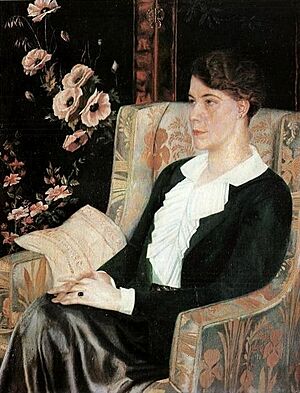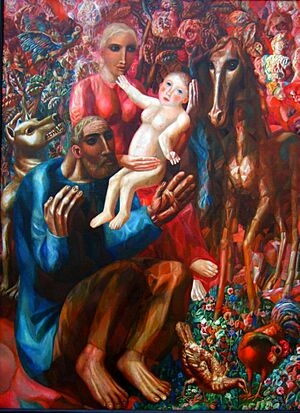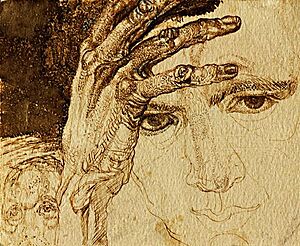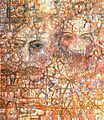Pavel Filonov facts for kids
Quick facts for kids
Pavel Filonov
|
|
|---|---|
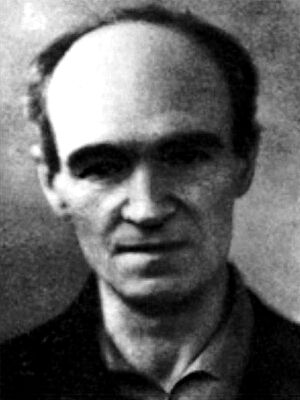
1938-1939
|
|
| Born | January 8, 1883 |
| Died | December 3, 1941 (aged 58) |
| Nationality | Russian |
| Known for | Painting |
Pavel Filonov was a talented Russian artist who lived from 1883 to 1941. He was known for his unique style of painting, which was part of the Russian avant-garde movement. This means he was one of the artists who created new and experimental art. He was also a thinker about art and a poet.
Contents
A Young Artist's Life
Pavel Filonov was born in Moscow, Russia, on January 8, 1883. When he was about 14, in 1897, he moved to St. Petersburg. There, he started taking art lessons to learn how to paint.
In 1908, he joined the St. Petersburg Academy of Arts. However, he was asked to leave in 1910. This was because his ideas about art were very different from what the academy taught.
Developing a New Art Style
Between 1910 and 1914, Filonov was part of an art group called Soyuz Molodyozhi, which means "Union of Youth." During this time, he developed his own special art style. He called it "analytical realism" or "anti-Cubism."
He wrote an article in 1912 called The Canon and the Law. In it, he explained his ideas. While Cubism showed objects by breaking them into geometric shapes, Filonov believed artists should show the "inner soul" of objects. He stuck to these ideas for his whole life.
Art and Revolution
From 1913 to 1915, Filonov worked closely with other famous Russian artists and poets. These included Vladimir Mayakovsky and Velimir Khlebnikov. He even helped illustrate one of Khlebnikov's poetry books.
In 1916, he joined the army during World War I. He served on the Romanian front. After the war, Filonov played an active part in the Russian Revolution of 1917. He even became the chairman of a special committee in the Dunay region.
Teaching and Challenges
In 1919, Filonov showed his art at a big exhibition in the Hermitage Museum. In 1923, he became a professor at the St. Petersburg Academy of Arts. He also joined a group called the Institute for Artistic Culture.
Filonov started a large art school where he taught his unique style. More than 70 artists learned from him. Their work had an impact on other art movements like suprematism and expressionism.
In 1929, a big show of Filonov's art was planned at the Russian Museum. But the Soviet government stopped the exhibition from happening. From 1932 onwards, Filonov faced very hard times. He often didn't have enough food. Even so, he refused to sell his paintings to private collectors. He wanted to give all his artworks to the Russian Museum. His dream was to start a special Museum of Analytical Realism.
Pavel Filonov sadly died from starvation on December 3, 1941. This happened during the terrible Siege of Leningrad, when the city was surrounded and many people suffered.
How Filonov Painted
Filonov had a special way of painting that he called "Universal Flowering." He believed that artists should build up their paintings from tiny details. He thought it was wrong to start with big shapes and then add small parts.
Because of this, he used very small brushes for his paintings. For drawings, he used the finest pencils. He also made sure his students worked in the same detailed way.
Filonov's Art Lives On
Most of Filonov's amazing artworks were saved by his sister, Yevdokiya Nikolayevna Glebova. She kept the paintings safe in the Russian Museum's archives. Later, she officially gave them to the museum as a gift.
For a long time, exhibitions of Filonov's work were not allowed. But in 1967, an exhibition of his art was finally permitted in Novosibirsk. Then, in 1988, his work was allowed to be shown in the Russian Museum. The first international exhibition of his art happened in Paris in 1989 and 1990.
There was a fun story that went around about Filonov's art. People said that Filonov's ghost protected his paintings. If anyone tried to steal his art or take it out of the country illegally, they would soon have bad luck.
Selected Works
See also
- Fine Art of Leningrad


